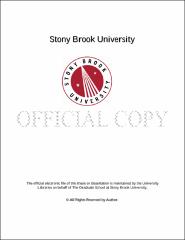| dc.identifier.uri | http://hdl.handle.net/11401/76938 | |
| dc.description.sponsorship | This work is sponsored by the Stony Brook University Graduate School in compliance with the requirements for completion of degree. | en_US |
| dc.format | Monograph | |
| dc.format.medium | Electronic Resource | en_US |
| dc.language.iso | en_US | |
| dc.publisher | The Graduate School, Stony Brook University: Stony Brook, NY. | |
| dc.type | Dissertation | |
| dcterms.abstract | piRNA pathway and its central components, PIWI proteins, are essential for transposon silencing and some aspects of gene regulation. Although they predominantly function in the animal germline, increasing evidence has pointed to their involvement in somatic cells. Some flatworms possess a unique somatic stem cell system named neoblasts. These totipotent cells are the only dividing cell population thus critical for postembryonic development, adult homeostasis and the remarkable regeneration ability. In the study led by Kaja A. Wasik and me, we identify and characterize piRNAs and PIWI proteins in the emerging regenerative flatworm model, Macrostomum lignano, combining targeted gene knockdown and deep sequencing. We find that M. lignano has a highly conserved piRNA pathway utilizing at least three PIWI proteins in the germline and somatic stem cells. One of the PIWIs, Macpiwi1, acts as a pivotal player by interacting with the primary piRNAs in a heterogenic secondary piRNA biogenesis. Knockdown of Macpiwi1 dramatically reduces piRNA levels, derepresses transposons, and severely impacts stem cell maintenance. Knockdown of the piRNA biogenesis factor Macvasa causes an even greater reduction in piRNA levels, with a corresponding increase in transposons. Yet, in Macvasa knockdown worms, we detect no major impact on stem cell self-renewal. These results may suggest stem cell maintenance functions of PIWI proteins in flatworms that are distinguishable from their impact on transposons and that might function independently of what are considered canonical piRNA populations. | |
| dcterms.available | 2017-09-20T16:51:28Z | |
| dcterms.contributor | Hannon, Gregory J | en_US |
| dcterms.contributor | Czaplinski, Kevin | en_US |
| dcterms.contributor | Ju, Jingfang | en_US |
| dcterms.contributor | Hammell, Christopher | en_US |
| dcterms.contributor | Timmermans, Marja. | en_US |
| dcterms.creator | Zhou, Xin | |
| dcterms.dateAccepted | 2017-09-20T16:51:28Z | |
| dcterms.dateSubmitted | 2017-09-20T16:51:28Z | |
| dcterms.description | Department of Biochemistry and Cell Biology. | en_US |
| dcterms.extent | 253 pg. | en_US |
| dcterms.format | Application/PDF | en_US |
| dcterms.format | Monograph | |
| dcterms.identifier | http://hdl.handle.net/11401/76938 | |
| dcterms.issued | 2015-12-01 | |
| dcterms.language | en_US | |
| dcterms.provenance | Made available in DSpace on 2017-09-20T16:51:28Z (GMT). No. of bitstreams: 1
Zhou_grad.sunysb_0771E_12571.pdf: 20373280 bytes, checksum: 0c763083abcc5e8f32c3e619049c47bd (MD5)
Previous issue date: 1 | en |
| dcterms.publisher | The Graduate School, Stony Brook University: Stony Brook, NY. | |
| dcterms.subject | Molecular biology | |
| dcterms.subject | Macrostomum, piRNAs, PIWI proteins, stem cell maintenance, transposon silencing | |
| dcterms.title | The piRNA pathway in the somatic stem cells of a regeneration-competent flatworm, Macrostomum lignano | |
| dcterms.type | Dissertation | |

